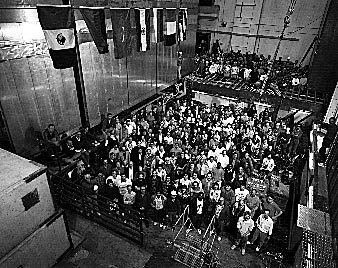Inquiring Minds
|
Physics at Fermilab main page | accelerators | collider experiments | neutrino physics | technology computing | theory | astrophysics | discoveries at Fermilab |
|
|
|
 A look back in time: DZero in 1995
A look back in time: DZero in 1995
The DZero collaboration is one of two teams of experimenters studying the top quark in particle collisions at Fermilab's Tevatron, the world's most powerful particle accelerator. Why does it take 450 physicists to go after one small quark? The answer lies in the size and complexity of the instruments for high-energy physics research and the vast amount of data they collect. Today's experiments require the efforts of hundreds of scientists to design and build the detectors capable of discovering the top quark. Department of Energy national laboratories like Fermilab give physicists from many U.S. and foreign universities the experimental resources they need to combine forces and work together on experiments at the forefront of particle physics research.
DZero collaborators
Collaborators , Affiliations and
Spokespersons in DZero Collaboration The men and women gathered in this picture are members of a team of 450 physicists and students from universities across the U.S. and throughout the world who work together on the DZero collaboration, an experiment named for the location of their collider detector on the Fermilab Tevatron accelerator ring. DZero is one of two teams of experimenters at Fermilab who study the top quark, an elementary particle of matter, in particle collisions at the Laboratory's accelerator. Top is the last quark to be discovered, of a family of six predicted by current physics theory. This final quark proved hard to find, mostly because it is much heavier than its five siblings. The greater a particle's mass, the more energy is required to produce it, the more rarely it appears as the result of particle collisions, and the harder it is to detect and study. DZero's experimental apparatus took more than $50 million and eight years of work by many physicists and engineers to design and build. The collaboration must keep the detector working at the peak of its capability. Each of its several subsystems is more complex in itself than an entire experiment of just a few years ago. A discovery signal consists of only a few events--a mere handful of the several million million proton-antiproton collisions that occur during a months-long collider run at the Fermilab accelerator. To keep the detector running smoothly requires thousands of hours of physicists' effort each week, full-time jobs for something approaching 200 physicists, many of whom are also university professors with teaching responsibilities, or graduate students with courses to complete. Besides the care and feeding of the detector, physicists on the DZero collaboration have the equally challenging job of managing and analyzing the data their detector collects. When the experiment has accumulated data from a few months of operation, the numerical representations of the 10 to 20 million stored collision events occupy about 10 million million bytes of computer disk space. Teams of experimenters write the computer code to reconstruct collision events from the stored data. Others write the complicated computer instructions to winnow the few interesting top quark candidate events from the huge haystack of data. Physics analysis, the effort to interpret the data, takes the efforts of the entire collaboration, double and triple checking every aspect of each others' conclusions, as they seek to understand the fundamental nature of matter and energy. |
| last modified 02/26/2001 email Fermilab |
FRLsDFx9eyfrPXgV



